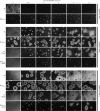The Paradoxical Effect of Echinocandins in Aspergillus fumigatus Relies on Recovery of the β-1,3-Glucan Synthase Fks1
- PMID: 27872079
- PMCID: PMC5278722
- DOI: 10.1128/AAC.01690-16
The Paradoxical Effect of Echinocandins in Aspergillus fumigatus Relies on Recovery of the β-1,3-Glucan Synthase Fks1
Abstract
Echinocandins target the fungal cell wall by inhibiting biosynthesis of the cell wall carbohydrate β-1,3-glucan. This antifungal drug class exhibits a paradoxical effect that is characterized by the resumption of growth of otherwise susceptible strains at higher drug concentrations (approximately 4 to 32 μg/ml). The nature of this phenomenon is still unknown. In this study, we analyzed the paradoxical effect of the echinocandin caspofungin on the pathogenic mold Aspergillus fumigatus Using a conditional fks1 mutant, we show that very high caspofungin concentrations exert an additional antifungal activity besides inhibition of the β-1,3-glucan synthase. This activity could explain the suppression of paradoxical growth at very high caspofungin concentrations. Additionally, we found that exposure to inhibitory caspofungin concentrations always causes initial growth deprivation independently of the capability of the drug concentration to induce the paradoxical effect. Paradoxically growing hyphae emerge from microcolonies essentially devoid of β-1,3-glucan. However, these hyphae expose β-1,3-glucan again, suggesting that β-1,3-glucan synthesis is restored. In agreement with this hypothesis, we found that expression of the β-1,3-glucan synthase Fks1 is an essential requirement for the paradoxical effect. Surprisingly, overexpression of fks1 renders A. fumigatus more susceptible, whereas reduced expression leads to hyphae that are more resistant to the growth-inhibitory and limited fungicidal activity of caspofungin. Upregulation of chitin synthesis appears to be of minor importance for the paradoxical effect, since paradoxically growing hyphae exhibit significantly less chitin than the growth-deprived parental microcolonies. Our results argue for a model where the paradoxical effect primarily relies on recovery of β-1,3-glucan synthase activity.
Keywords: Aspergillus fumigatus; caspofungin; echinocandin; fks1; glucan synthase; paradoxical effect.
Copyright © 2017 American Society for Microbiology.
Figures






Similar articles
-
Caspofungin-Mediated Growth Inhibition and Paradoxical Growth in Aspergillus fumigatus Involve Fungicidal Hyphal Tip Lysis Coupled with Regenerative Intrahyphal Growth and Dynamic Changes in β-1,3-Glucan Synthase Localization.Antimicrob Agents Chemother. 2017 Sep 22;61(10):e00710-17. doi: 10.1128/AAC.00710-17. Print 2017 Oct. Antimicrob Agents Chemother. 2017. PMID: 28760907 Free PMC article.
-
Aspergillus fumigatus devoid of cell wall β-1,3-glucan is viable, massively sheds galactomannan and is killed by septum formation inhibitors.Mol Microbiol. 2015 Feb;95(3):458-71. doi: 10.1111/mmi.12877. Epub 2014 Dec 30. Mol Microbiol. 2015. PMID: 25425041
-
The Aspergillus fumigatus CrzA Transcription Factor Activates Chitin Synthase Gene Expression during the Caspofungin Paradoxical Effect.mBio. 2017 Jun 13;8(3):e00705-17. doi: 10.1128/mBio.00705-17. mBio. 2017. PMID: 28611248 Free PMC article.
-
Characterization of Aspergillus fumigatus mutants with reduced susceptibility to caspofungin.Med Mycol. 2005 May;43 Suppl 1:S299-305. doi: 10.1080/13693780400029023. Med Mycol. 2005. PMID: 16110824 Review.
-
Current perspectives on echinocandin class drugs.Future Microbiol. 2011 Apr;6(4):441-57. doi: 10.2217/fmb.11.19. Future Microbiol. 2011. PMID: 21526945 Free PMC article. Review.
Cited by
-
Differentially Regulated Transcription Factors and ABC Transporters in a Mitochondrial Dynamics Mutant Can Alter Azole Susceptibility of Aspergillus fumigatus.Front Microbiol. 2020 May 26;11:1017. doi: 10.3389/fmicb.2020.01017. eCollection 2020. Front Microbiol. 2020. PMID: 32528443 Free PMC article.
-
Structural Polymorphism of Chitin and Chitosan in Fungal Cell Walls From Solid-State NMR and Principal Component Analysis.Front Mol Biosci. 2021 Aug 25;8:727053. doi: 10.3389/fmolb.2021.727053. eCollection 2021. Front Mol Biosci. 2021. PMID: 34513930 Free PMC article.
-
New Vision of Cell Walls in Aspergillus fumigatus from Solid-State NMR Spectroscopy.J Fungi (Basel). 2024 Mar 16;10(3):219. doi: 10.3390/jof10030219. J Fungi (Basel). 2024. PMID: 38535227 Free PMC article. Review.
-
Caspofungin-Mediated Growth Inhibition and Paradoxical Growth in Aspergillus fumigatus Involve Fungicidal Hyphal Tip Lysis Coupled with Regenerative Intrahyphal Growth and Dynamic Changes in β-1,3-Glucan Synthase Localization.Antimicrob Agents Chemother. 2017 Sep 22;61(10):e00710-17. doi: 10.1128/AAC.00710-17. Print 2017 Oct. Antimicrob Agents Chemother. 2017. PMID: 28760907 Free PMC article.
-
Recent Insights into the Paradoxical Effect of Echinocandins.J Fungi (Basel). 2017 Dec 28;4(1):5. doi: 10.3390/jof4010005. J Fungi (Basel). 2017. PMID: 29371498 Free PMC article. Review.
References
MeSH terms
Substances
LinkOut - more resources
Full Text Sources
Other Literature Sources

